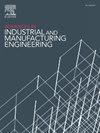Deformation behavior of anisotropic TA18 titanium alloy tube in hydroforming process at room temperature
IF 6
Q2 ENGINEERING, INDUSTRIAL
Advances in Industrial and Manufacturing Engineering
Pub Date : 2025-03-15
DOI:10.1016/j.aime.2025.100159
引用次数: 0
Abstract
While hydroforming of titanium alloy at room temperature is difficult due to its high strength, low hardening capacity, and significant springback, it is typically deformed into desired shape under high-temperature conditions exceeding 500°C, which increases the complexity of the process and raises costs. In this paper, the hydroforming method was used to manufacture TA18 titanium alloy variable-diameter tubular components at room temperature based on an innovative idea of useful wrinkles. The results show that the TA18 titanium alloy tube blank has a strong normal anisotropy of = 5.2, which is conducive to developing wrinkles while preventing excessive thinning. When the pressure increases from 0.4 ps (ps is initial yield internal pressure) to 0.8 ps, the number of wrinkles produced on the tube blanks gradually decreases from three to two, and their width increases. When the pressure exceeds ps, wrinkles cannot be formed on the tube blanks, which will undergo bulging deformation. In the simulation, the wrinkling behavior of the tube blanks does not match the experiment when the Mises yield criterion was used. While using the anisotropic Hill48 yield criterion, the wrinkling trend and development of wrinkles can be well predicted. Furthermore, the wrinkled tubes can be completely flattened under 70 MPa during calibration, and their wall thickness distributions are consistent with the simulation results, with the maximum thinning ratio of the formed components at 6.2%. All of these results provide basic support for manufacturing titanium alloy tubular components with large cross-sectional differences at room temperature using the hydroforming process.
各向异性TA18钛合金管材室温高压成形变形行为
由于钛合金的高强度、低硬化能力和明显的回弹,在室温下进行氢成形是困难的,而在超过500°C的高温条件下,它通常会变形成所需的形状,这增加了工艺的复杂性并提高了成本。本文基于有用皱折的创新思想,采用液压成形法在室温条件下制备了TA18钛合金变径管状构件。结果表明,TA18钛合金管坯具有很强的r形式的正交各向异性,其r形式的各向异性为5.2,在防止过度变薄的同时有利于皱褶的形成。当压力从0.4 ps (ps为初始屈服内压)增加到0.8 ps时,管坯上产生的起皱数从3个逐渐减少到2个,其宽度增加。当压力超过ps时,管坯不能形成起皱,会发生胀形变形。在模拟中,采用Mises屈服准则时管坯的起皱行为与实验结果不符。采用各向异性的Hill48屈服准则,可以很好地预测起皱趋势和皱褶的发展。此外,在70 MPa的压力下,皱管可以完全被压平,其壁厚分布与模拟结果一致,成形部件的最大变薄率为6.2%。这些结果为室温下采用液压成形工艺制造大截面差钛合金管状构件提供了基础支撑。
本文章由计算机程序翻译,如有差异,请以英文原文为准。
求助全文
约1分钟内获得全文
求助全文
来源期刊

Advances in Industrial and Manufacturing Engineering
Engineering-Engineering (miscellaneous)
CiteScore
6.60
自引率
0.00%
发文量
31
审稿时长
18 days
 求助内容:
求助内容: 应助结果提醒方式:
应助结果提醒方式:


